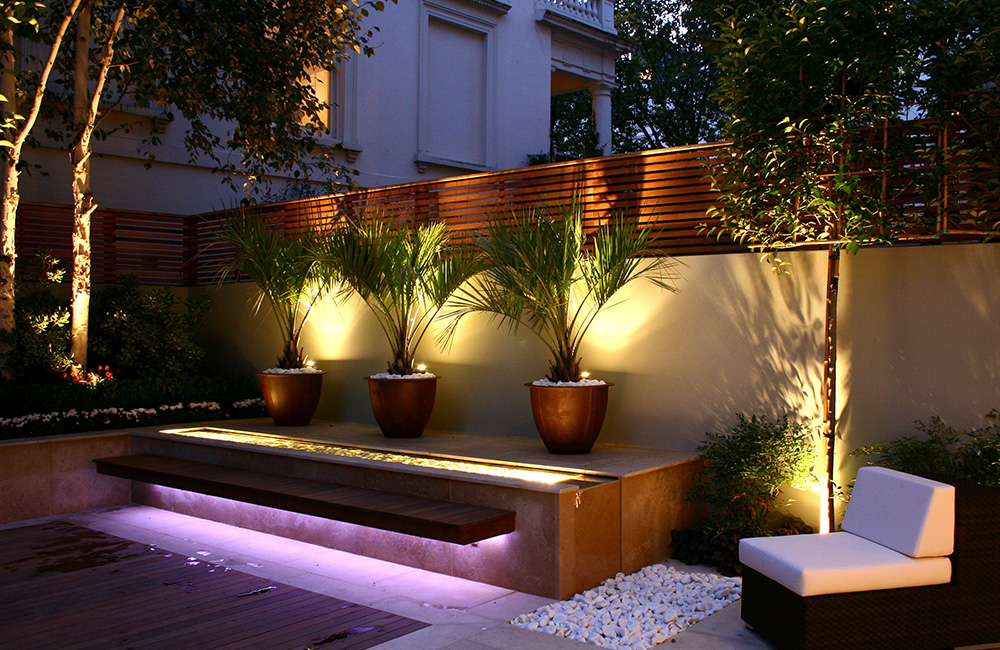Ways to make your garden more enticing in the evening.
Making the most of our gardens has never been as essential for us than right now. Our gardens are going to be the sanctuary we all need, the haven in which we can escape and reduce our anxiety and truly switch off from the world. With proposed weeks and possibly months of staying home Kate shares her suggestions and the ways in which you can light your garden to extend evenings spent outdoors or indeed brighten our outlook on to the garden when it may be the only view we are all going to see for a while.
Lighting is the perfect finishing touch to any garden no matter how big or small and there are lighting options which you can fit yourself if access to an electrician is difficult I do always advise our clients to make sure they buy the best fittings they can afford to withstand the outdoor elements or be prepared to take your lighting indoors when it is not in use.
To quote from my book: “The topic of garden lighting is so broad that I could write a whole book about it.”
For the purposes of this topic in the current climate though I will focus on lighting options you can order online and fit yourself. Every garden and every site is different though and various lighting styles or indeed how much lighting to use will vary for every garden depending on it’s unique situation or surroundings or indeed your taste.
There are some areas where you may not be able to use lights, such as conservation areas or areas of street darkness, lighting in these instances could be a distraction for passing traffic. In addition, trees with a Tree Preservation Order (TPO) cannot be lit or have lights fixed to them. Before you start ordering anything it will be best to check what your circumstances are and do some of your own research.
Below I have put together my suggestions for lighting methods you will be able to order online. It is still a good idea to plan your lighting though using, scrap books, mood boards or Pinterest rather than just buying a load of different items without knowing where they will go and if they will work together. Planning will ensure you create the best effect and have the ability to create different atmosphere’s for different occasions.
I have also previously suggested that clients light tealights and place them around the garden to get an idea of how the lighting will look where you are hoping to place them. Lighting is most effective when complimented by darkness. Not everything in your garden has to be lit at once. Think of the garden as if it were a room that needs different levels of light to create different effects.
Here are some things to consider:
- Perhaps you need a base setting to highlight changes of level, steps or the bottom of walls for safety.
- Trees and architectural plants are the next setting, followed by lower-storey plants.
- Water features and sculptural items should be lit and you may wish to illuminate these elements as standalone pieces to create high drama.
Types of Lighting:
Solar Lighting
If you are wanting to mark level changes or would like to line a path then solar lights are a good choice. Solar lights need to be sited away from foliage and in full sun to ensure the panel receives a good charge each day. Solar lights automatically come on when the light levels get low. As long as they have a good amount of light during the day, they are a reliable light source for the garden. There are loads of options to purchase online and once they are placed and you are happy will immediately start working.
Candles & Lanterns
Lanterns with battery operated candles or real wax candles create focal points on patios or balconies. Lanterns along a path way look beautiful. Candles can only be used in fair weather and when supervised, burning candles left unattended can be extremely dangerous. The light emitted from candles can only simply be “flame coloured”. The upshot of candles and lanterns though is that the type of light they give off is considered to be the most attractive type of light, also the most atmospheric and some say flattering.
Fairy & Festoon
Another great option if you are looking for lighting that you can easily install yourself is festoon or fairy lights. You have to make sure the type you purchase are suitable for outdoors. This style of lighting is best used sparingly or in focussed areas. Festoons hung over a patio or in an overlooked small garden to give a sense of enclosure and privacy can make your garden inviting and cosy for those sunny Spring evenings or as the light starts to wane later on.
There are no rules with lighting your garden but always err on the side of caution – you can always add more lights, but taking them away is more difficult. Adding drama where you have architectural plants or forms and contrasting those with areas with spaces where there are no lights, thereby enhances the focal point. Practical matters also take consideration with lighting and generally I would start with areas that need to be lit for safety and then add detail after that.
Lighting tips for country gardens or larger estate gardens
- Create zones with different types of lighting and areas that are brighter or lower level light giving interest to a large space.
- You are likely to have more friendly wildlife visitors so make sure the lighting you choose doesn’t affect these creature adversely, particularly bats, making sure they are still able to feed in your garden undisturbed.
- Consider flight paths in the area, if in doubt err on the side of caution – less is more.
Lighting tips for basement gardens
- Angle lights downwards to avoid shining light into your neighbours’ windows.
- Create drama by using light to highlight architectural forms. Choose small spike lights with angled
heads so you can fine-tune the effect, especially as plants grow.
- Basement spaces are dark by nature, so add light sparingly to avoid a too-bright effect.
- Avoid solar lights because they probably will not charge adequately in the shade of a basement.
Lighting tips for small town gardens and courtyards
- Light feature plants to create an enticing effect.
- Light paving only if truly necessary, if it is needed to highlight level changes or steps or as markers to a gate or to bins.
- Utilise multiple circuits to give you the greatest flexibility.
- Don’t forget about candle power – it may be the answer to a soft lighting scheme in the summer.
Lighting tips for roof terraces and balconies
- Don’t use uplights in paving because, with nothing above them, their effect will be lost as they shine into the sky.
- Avoid a strong light display as this will draw attention to the roof and cause conflict with neighbours.
- Try to keep light within the space to avoid unnecessary light pollution.
- Consider installing solar lights. They should charge well on a roof or balcony with good light.



